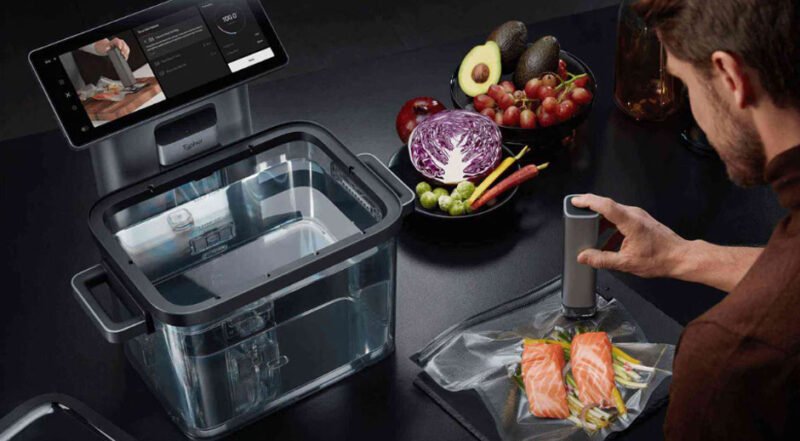Sous vide cooking has become increasingly popular among home chefs and professional kitchens alike due to its ability to produce consistently perfect results. By cooking food in a precisely controlled water bath, sous vide ensures even cooking, enhanced flavors, and optimal textures. Whether you’re a beginner or an experienced cook, mastering sous vide can elevate your cooking to a whole new level. In this article, we’ll explore some essential sous vide cooking tips that will help you achieve perfect results every time.
What is Sous Vide Cooking?
Sous vide, French for “under vacuum,” is a method of cooking food by sealing it in an airtight bag and submerging it in a precisely controlled water bath at a low, consistent temperature. This technique ensures that food is cooked evenly throughout, retaining its moisture, flavor, and nutrients. The low temperature prevents overcooking, which is one of the biggest challenges in traditional cooking methods.
The sous vide technique allows for unprecedented control over the cooking process, and when done right, it produces results that are hard to achieve using other methods. It’s perfect for cooking everything from meats, poultry, seafood, and vegetables to eggs and desserts.
1. Choose the Right Equipment for Sous Vide Cooking
The first step to successful sous vide cooking is choosing the right equipment. While there are several options available, investing in the right tools will make the process smoother and more reliable. Here’s what you need:
- Precision Sous Vide Cooker: The heart of sous vide cooking, this device circulates water at a precise temperature to ensure consistent cooking. Look for a high-quality immersion circulator with a wide temperature range and reliable accuracy.
- Water Bath Container: A container to hold the water bath. While you can use any heatproof container, some immersion circulators come with their own containers, which may offer better insulation.
- Vacuum Sealer: To seal food in airtight bags. Although you can use zip-lock bags with the water displacement method, a vacuum sealer is more efficient and helps create a tighter seal, ensuring better results.
- Tongs or a Lift Basket: To remove food from the water bath safely after cooking.
- Timer: While most sous vide cookers have built-in timers, an external timer can help ensure you don’t overcook your food.
A high-quality sous vide machine is essential for achieving perfect results, and the Typhur Sous Vide Station stands out as one of the best options available. Whether you’re new to sous vide or a seasoned pro, the Typhur Sous Vide Station offers a comprehensive solution that simplifies the entire cooking process.
Why Choose the Typhur Sous Vide Station?
The Typhur Sous Vide Station is an all-in-one sous vide machine that integrates everything you need for sous vide cooking into one sleek, powerful unit. Unlike traditional sous vide setups, where you might need to buy separate components like a water bath container, immersion circulator, and vacuum sealing bags, the Typhur Sous Vide Station brings everything together in a single package, making it an ideal choice for both beginners and experienced chefs.

2. Use Fresh Ingredients
While sous vide is excellent at retaining flavors and moisture, it won’t work miracles with ingredients that are past their prime. For the best results, always use fresh, high-quality ingredients. Fresh meat, seafood, and vegetables will have better texture, flavor, and nutritional value after cooking sous vide.
When selecting meat, choose cuts that are suitable for sous vide, such as ribeye steaks, chicken breasts, pork chops, and lamb chops. For seafood, fish like salmon, cod, and shrimp are popular choices, as they cook well at lower temperatures without becoming overcooked or dry.
3. Season Your Ingredients Properly
Seasoning is key to bringing out the best flavors in your food. When cooking sous vide, you want to season your ingredients before sealing them in the bag. However, it’s important to remember that sous vide cooking enhances the natural flavors of food, so you don’t need to go overboard with heavy spices.
- Salt and Pepper: The basics. Salt helps draw out moisture and flavor from meat and vegetables, while pepper adds a subtle kick.
- Herbs and Aromatics: Fresh herbs like thyme, rosemary, and bay leaves work wonderfully with sous vide. You can also add garlic, lemon zest, or chili flakes for extra flavor.
- Marinades and Oils: You can marinate proteins before sealing them in the bag, but keep in mind that sous vide cooking preserves the marinate’s potency, so a little goes a long way. Olive oil is great for adding richness and a smooth texture, especially when cooking fish.
4. Get the Temperature Right
One of the most important aspects of sous vide cooking is the temperature. Cooking food at a precise, controlled temperature results in perfectly cooked dishes without the risk of overcooking. Here’s a general guide for common proteins:
- Chicken Breast: 140°F (60°C) for 1.5–2 hours for juicy and tender results.
- Beef Steak (Medium-Rare): 130°F (54°C) for 1–3 hours.
- Pork Chops: 140°F (60°C) for 1–2 hours for a tender, juicy texture.
- Salmon: 130°F (54°C) for 30–45 minutes for flaky, moist fish.
- Vegetables: Most vegetables do well between 183°F (84°C) and 185°F (85°C) for 1 to 1.5 hours.
Always make sure to check the temperature of your sous vide cooker before starting to ensure that it is calibrated correctly. Using a thermometer can help confirm that the water temperature is accurate.
5. Time Matters
Sous vide cooking requires time, but not necessarily as much as you might think. The cooking time varies depending on the thickness of the food and the desired result, but it’s important to stick to the right time range to avoid overcooking or undercooking.
- Thicker Cuts: The thicker the cut of meat, the longer the cook time required. A thick steak or roast might need 2 to 4 hours to cook fully, while thinner cuts like chicken breasts may only need 1 to 1.5 hours.
- Delicate Foods: Fish, eggs, and tender cuts of meat like chicken breast require shorter cooking times. Overcooking delicate foods can result in a mushy texture, so it’s best to stay within the recommended time frame.
- Don’t Rush: Sous vide cooking allows you to be more flexible with timing, but be mindful of your cooking window. If you leave food in the bath for too long, even at a low temperature, it can become too soft or mushy.
6. Sealing the Food Properly
For sous vide cooking to be successful, you need to seal your food in vacuum bags to ensure even cooking. The seal keeps the ingredients in place and prevents water from getting into the bag. Here are some sealing tips:
- Vacuum Seal Bags: A vacuum sealer is the most reliable way to seal food, ensuring no air is left inside the bag. This ensures even heat distribution and prevents the food from floating, which could lead to uneven cooking.
- Water Displacement Method: If you don’t have a vacuum sealer, you can use the water displacement method with zip-lock bags. Simply place the food in a resealable bag and submerge it in water, letting the pressure force the air out. Seal the bag just before it fully submerges.
7. Finishing Touches: Searing and Crispy Texture
Once your food has finished cooking sous vide, you can take it one step further by adding a sear to the surface. While sous vide cooking does an excellent job of cooking food to perfection, it doesn’t give it the crispy, browned texture that many people love. This is where a quick sear in a hot pan, on the grill, or with a blowtorch comes into play.
- Steak: After sous vide cooking, sear the steak on both sides in a hot pan with butter for 1–2 minutes per side.
- Chicken: Sear the skin side of the chicken breast or thighs in a pan to create a golden, crispy exterior.
- Fish: Lightly sear fish fillets on the skin side to crisp up the skin without overcooking the fish.
8. Don’t Forget to Rest Your Meat
After sous vide cooking, let your meat rest for a few minutes before cutting into it. This allows the juices to redistribute within the meat, resulting in a more flavorful and moist dish. While sous vide cooking ensures that the meat is perfectly cooked, resting helps achieve the best texture and flavor.
Conclusion: Mastering Sous Vide for Perfect Results Every Time
Sous vide cooking can be a game-changer in your kitchen, delivering professional-level results with minimal effort. By following these tips—choosing the right equipment, using fresh ingredients, seasoning properly, and ensuring correct temperatures and cooking times—you’ll be able to cook a variety of dishes with perfect consistency and flavor. With a little practice, you’ll unlock the full potential of sous vide and be able to create meals that impress even the most discerning palates.
Whether you’re cooking steaks, vegetables, seafood, or eggs, sous vide offers a level of precision and ease that traditional cooking methods can’t match. Once you’ve mastered the basics, the possibilities are endless, and you’ll be able to create delicious, perfectly cooked meals with confidence every time. Happy cooking!








